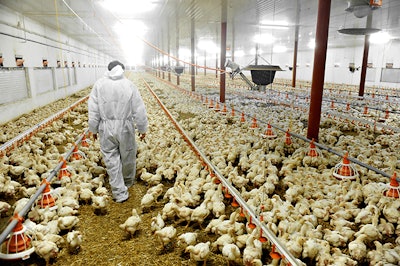
Antibiotics have commonly been utilized to keep animals healthy and to treat humans. Antimicrobial resistance continues to be a topic of conversation in the poultry industry because antibiotic overuse can lead to a loss of effectiveness when treating infections in chickens and lead to the development of resistant bacteria. In response to antibiotic resistance concerns and changing regulations, a 2019 study showed that Antibiotic use decreased significantly in both the broiler and turkey industries in recent years.
To provide therapeutics for use in poultry that are not antibiotics, Amphoraxe, a Vancouver-based biotechnology R&D company, is evaluating the use of naturally occurring antimicrobial peptides. Inanc Birol Ph.D., chief scientific officer, Amphoraxe Life Sciences Inc., presented why antimicrobial peptides (AMPs) could be used as a replacement for poultry antibiotics during the 2021 Poultry Tech Summit Webinar Series on November 10.
What are antimicrobial peptides?
According to Amphoraze’s website, AMPs are proteins that all living organisms produce naturally as part of their immune systems that could kill many kinds of bacteria, including medically important antibiotic resistant strains, without toxicity against animal cells.
“AMPs kill a broad spectrum of pathogens,” explained Birol. “They act faster, and they usually do not interact with the DNA of their target bacteria. As a result, the pathogens do not evolve into superbugs as fast as they would when treated with antibiotics.”
“Natural AMPs are encoded in the DNA of every species, and can become active peptides when needed,” added Birol. “We discovered the AMPs using genomic technologies.”
How they work
Birol explained that they start by obtaining the DNA and RNA strains of species. His lab specializes in developing specific algorithms that analyze this large number of sequences. The algorithms can reveal which sequences code for AMPs.
“We test our candidate AMPs against a range of bacterial species, including antibiotic resistant strains, and perform safety tests,” states Amphoraze’s website. “AMPs would be broken down in the animals and would not exist in the production of meat, eggs or waste products.”
“To date, we have discovered over 1,000 (unique) AMP species, and we are at various stages of validation for these,” concluded Birol. “The animal experiments for additional trials are going to start next year.”
What’s Next
For more on the technologies set to advance the poultry industry, join industry-changing innovators, researchers, entrepreneurs, technology experts, investors and leading poultry producers at the Poultry Tech Webinar Series, scheduled for November 30 and December 2.
During the webinar series, industry experts will preview what’s coming next – from prospective solutions to developing technology – for the poultry industry.
This webinar series is proudly sponsored by: Arm & Hammer, Aviagen, Baader, Boehringer Ingelheim, Cargill, Ceva, Chore-Time, Cobb, Evonik, Marel, Phibro Animal Health, Staubli, and Zoetis.
Visit our website for more details on the webinar series, topics and speakers.
Register for free today and join us for a glimpse at the future of the poultry industry.

















